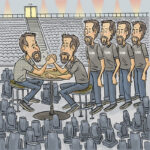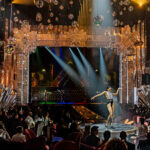Visualizers are wonderful tools that can be extremely useful to programmers and productions alike. However, there are always differences between the virtual world in the computer and the real world happening live on stage. When a programmer commands a light to zoom from narrow to wide, for example, most visualizers will get the direction of the zoom correct, but most visualizers do not perfectly emulate the mechanical movement times of fixture features. So if you command a fixture to zoom from narrow to wide in zero time, you may see it instantly change on your computer screen, but a real light might take 1.5 seconds to move its lenses accordingly. The same holds true for fixtures that contain effect channels for triggering gobo rotations, strobing, chases, internal effects, and more. Because the effect information is stored in each fixture and not based on changing DMX values, it is nearly impossible for a visualizer company to replicate these on the screen…In an ideal situation, a programmer will have one real fixture (of each type of fixture in the plot) connected to the desk during visualization. This provides a reference to reality as you can easily see what the actual fixture is doing in comparison to the image on the screen. This practice is also beneficial when true color is essential.
—Brad Schiller, from Feeding the Machines, PLSN, July 2016, page 57


